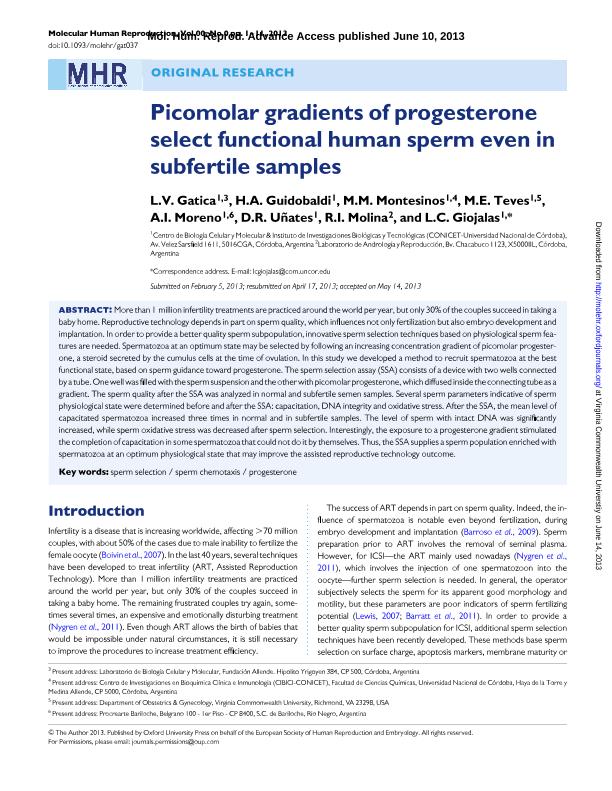Mostrar el registro sencillo del ítem
dc.contributor.author
Gatica, Laura Virginia

dc.contributor.author
Guidobaldi, Héctor Alejandro

dc.contributor.author
Montesinos, Maria del Mar

dc.contributor.author
Teves, Maria Eugenia

dc.contributor.author
Moreno, Ignacio Alejandro

dc.contributor.author
Uñates, Diego Rafael

dc.contributor.author
Molina, R. I.
dc.contributor.author
Giojalas, Laura Cecilia

dc.date.available
2017-09-29T19:28:58Z
dc.date.issued
2013-05
dc.identifier.citation
Gatica, Laura Virginia; Guidobaldi, Héctor Alejandro; Montesinos, Maria del Mar; Teves, Maria Eugenia; Moreno, Ignacio Alejandro; et al.; Picomolar gradients of progesterone select functional human sperm even in subfertile samples; Oxford University Press; Molecular Human Reproduction; 19; 9; 5-2013; 559-569
dc.identifier.issn
1360-9947
dc.identifier.uri
http://hdl.handle.net/11336/25462
dc.description.abstract
More than 1 million infertility treatments are practiced around the world per year, but only 30% of the couples succeed in taking a baby home. Reproductive technology depends in part on sperm quality, which influences not only fertilization but also embryo development and implantation. In order to provide a better quality sperm subpopulation, innovative sperm selection techniques based on physiological sperm features are needed. Spermatozoa at an optimum state may be selected by following an increasing concentration gradient of picomolar progesterone, a steroid secreted by the cumulus cells at the time of ovulation. In this study we developed a method to recruit spermatozoa at the best functional state, based on sperm guidance toward progesterone. The sperm selection assay (SSA) consists of a device with two wells connected by a tube.One well was filled with the sperm suspension and the other with picomolar progesterone, which diffused inside the connecting tube as a gradient. The sperm quality after the SSA was analyzed in normal and subfertile semen samples. Several sperm parameters indicative of sperm physiological state were determined before and after the SSA: capacitation, DNA integrity and oxidative stress. After the SSA, the mean level of capacitated spermatozoa increased three times in normal and in subfertile samples. The level of sperm with intact DNA was significantly increased, while sperm oxidative stress was decreased after sperm selection. Interestingly, the exposure to a progesterone gradient stimulated the completion of capacitation in some spermatozoa that could not do it by themselves. Thus, the SSA supplies a sperm population enriched with spermatozoa at an optimum physiological state that may improve the assisted reproductive technology outcome.
dc.format
application/pdf
dc.language.iso
eng
dc.publisher
Oxford University Press

dc.rights
info:eu-repo/semantics/openAccess
dc.rights.uri
https://creativecommons.org/licenses/by-nc-sa/2.5/ar/
dc.subject
Espermtozoides
dc.subject
Progesterona
dc.subject
Seleccion Espermatica
dc.subject
Quimiotaxis
dc.subject.classification
Ética relacionada con Biotecnología Médica

dc.subject.classification
Biotecnología de la Salud

dc.subject.classification
CIENCIAS MÉDICAS Y DE LA SALUD

dc.title
Picomolar gradients of progesterone select functional human sperm even in subfertile samples
dc.type
info:eu-repo/semantics/article
dc.type
info:ar-repo/semantics/artículo
dc.type
info:eu-repo/semantics/publishedVersion
dc.date.updated
2017-09-28T19:04:45Z
dc.journal.volume
19
dc.journal.number
9
dc.journal.pagination
559-569
dc.journal.pais
Reino Unido

dc.journal.ciudad
Oxford
dc.description.fil
Fil: Gatica, Laura Virginia. Consejo Nacional de Investigaciones Científicas y Técnicas. Centro Científico Tecnológico Conicet - Córdoba. Instituto de Investigaciones Biológicas y Tecnológicas. Universidad Nacional de Córdoba. Facultad de Ciencias Exactas, Físicas y Naturales. Instituto de Investigaciones Biológicas y Tecnológicas; Argentina
dc.description.fil
Fil: Guidobaldi, Héctor Alejandro. Consejo Nacional de Investigaciones Científicas y Técnicas. Centro Científico Tecnológico Conicet - Córdoba. Instituto de Investigaciones Biológicas y Tecnológicas. Universidad Nacional de Córdoba. Facultad de Ciencias Exactas, Físicas y Naturales. Instituto de Investigaciones Biológicas y Tecnológicas; Argentina
dc.description.fil
Fil: Montesinos, Maria del Mar. Consejo Nacional de Investigaciones Científicas y Técnicas. Centro Científico Tecnológico Conicet - Córdoba. Instituto de Investigaciones Biológicas y Tecnológicas. Universidad Nacional de Córdoba. Facultad de Ciencias Exactas, Físicas y Naturales. Instituto de Investigaciones Biológicas y Tecnológicas; Argentina
dc.description.fil
Fil: Teves, Maria Eugenia. Consejo Nacional de Investigaciones Científicas y Técnicas. Centro Científico Tecnológico Conicet - Córdoba. Instituto de Investigaciones Biológicas y Tecnológicas. Universidad Nacional de Córdoba. Facultad de Ciencias Exactas, Físicas y Naturales. Instituto de Investigaciones Biológicas y Tecnológicas; Argentina
dc.description.fil
Fil: Moreno, Ignacio Alejandro. Consejo Nacional de Investigaciones Científicas y Técnicas. Centro Científico Tecnológico Conicet - Córdoba. Instituto de Investigaciones Biológicas y Tecnológicas. Universidad Nacional de Córdoba. Facultad de Ciencias Exactas, Físicas y Naturales. Instituto de Investigaciones Biológicas y Tecnológicas; Argentina
dc.description.fil
Fil: Uñates, Diego Rafael. Consejo Nacional de Investigaciones Científicas y Técnicas. Centro Científico Tecnológico Conicet - Córdoba. Instituto de Investigaciones Biológicas y Tecnológicas. Universidad Nacional de Córdoba. Facultad de Ciencias Exactas, Físicas y Naturales. Instituto de Investigaciones Biológicas y Tecnológicas; Argentina
dc.description.fil
Fil: Molina, R. I.. Laboratorio de Andrología y Reproducción; Argentina
dc.description.fil
Fil: Giojalas, Laura Cecilia. Consejo Nacional de Investigaciones Científicas y Técnicas. Centro Científico Tecnológico Conicet - Córdoba. Instituto de Investigaciones Biológicas y Tecnológicas. Universidad Nacional de Córdoba. Facultad de Ciencias Exactas, Físicas y Naturales. Instituto de Investigaciones Biológicas y Tecnológicas; Argentina
dc.journal.title
Molecular Human Reproduction

dc.relation.alternativeid
info:eu-repo/semantics/altIdentifier/doi/http://dx.doi.org/10.1093/molehr/gat037
dc.relation.alternativeid
info:eu-repo/semantics/altIdentifier/url/https://academic.oup.com/molehr/article-lookup/doi/10.1093/molehr/gat037
Archivos asociados
